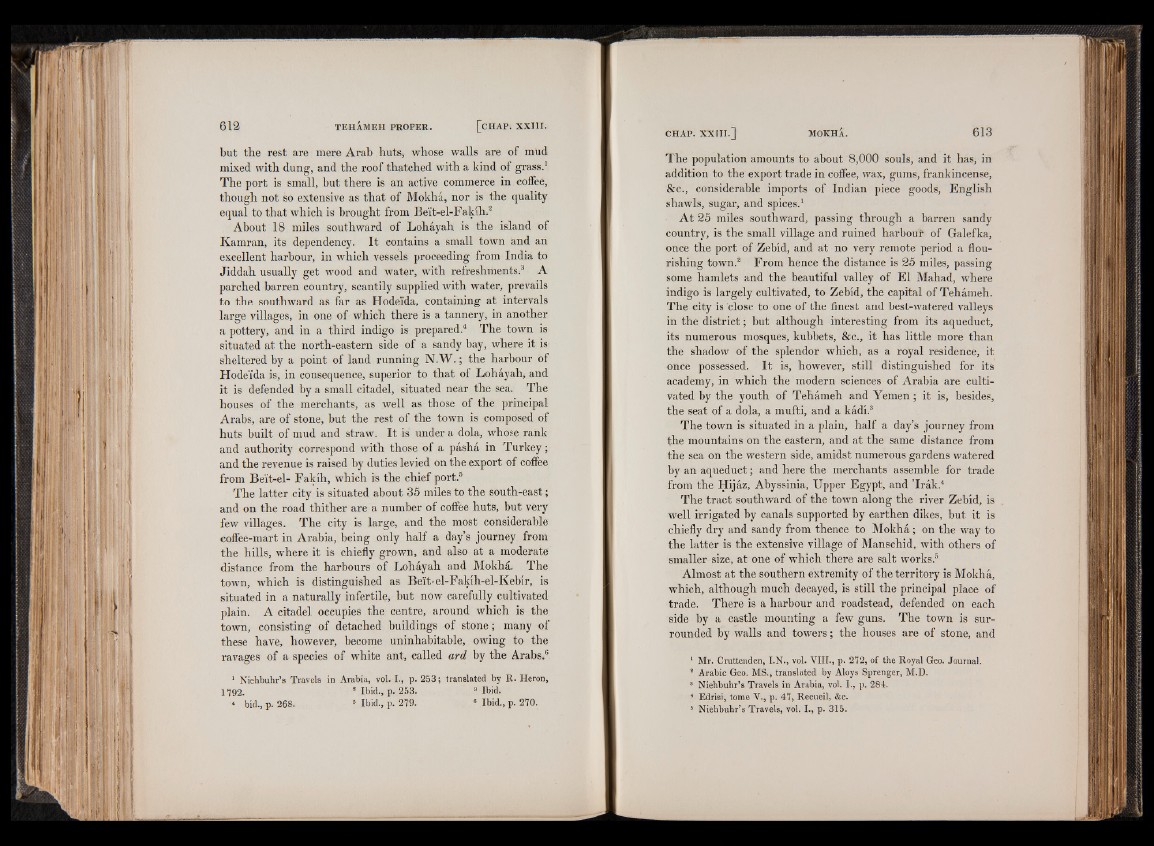
but tbe rest are mere Arab huts, whose walls are of mud
mixed with dung, and the roof thatched with a kind of grass.1
The port is small, but there is an active commerce in coffee,
though not so extensive as that of Mokha, nor is the quality
equal to that which is brought from Beit-el-Faldh.2
About 18 miles southward of Lohayah is the island of
Kamran, its dependency. It contains a small town and an
excellent harbour, in which vessels proceeding from India to
Jiddah usually get wood and water, with refreshments;3 A
parched barren country, scantily supplied with water, prevails
to the southward as far as Hode'ida, containing at intervals
large villages, in one of which there is a tannery, in another
a pottery, and in a third indigo is prepared.4 The town is
situated at the north-eastern side of a sandy bay, where it is
sheltered by a point of land running N .W .; the harbour of
Hode'ida is, in consequence, superior to that of Lohayah, and
it is defended by a small citadel, situated near the sea. The
houses of the merchants, as well as those of the principal
Arabs, are of stone, but the rest of the town is composed of
huts built of mud and straw. It is under a dola, whose rank
and authority correspond with those of a pasha in Turkey;
and the revenue is raised by duties levied on the export of coffee
from Beit-el- Fakih, which is the chief port.5
The latter city is situated about 35 miles to the south-east;
and on the road thither are a number of coffee huts, but very
few villages. The city is large, and the most considerable
coffee-mart in Arabia, being only half a day’s journey from
the hills, where it is chiefly grown, and also at a moderate
distance from the harbours of Lohayah and Mokha. The
town, which is distinguished as Beit-el-Fakih-el-Kebir, is
situated in a naturally infertile, but now carefully cultivated
plain. A citadel occupies the centre, around which is the
town, consisting of detached buildings of stone; many of
these have, however, become uninhabitable, owing to the
ravages of a species of white ant, called ard by the Arabs.6
1 Niehbuhr’s Travels in Arabia, vol. I j p. 253; translated by R. Heron,
17 9 2 . s Ibid., p. 253. 3 Ibid.
‘ bid., p. 268. 5 Ibid., p. 279. 6 Ibid., p. 210.
The population amounts to about 8,000 souls, and it has, in
addition to the export trade in coffee, wax, gums, frankincense,
&c., considerable imports of Indian piece goods, English
shawls, sugar, and spices.1
At 25 miles southward, passing through a barren sandy
country, is the small village and ruined harbour of Galefka,
once the port of Zebid, and at no very remote period a flourishing
town.2 From hence the distance is 25 miles, passing
some hamlets and the beautiful valley of El Mahad, where
indigo is largely cultivated, to Zebid, the capital of Tehameh.
The city is close to one of the finest and best-watered valleys
in the district; but although interesting from its aqueduct,
its numerous mosques, kubbets, &c., it has little more than
the shadow of the splendor which, as a royal residence, it
once possessed. It is, however, still distinguished for its
academy, in which the modern sciences of Arabia are cultivated
by the youth of Tehameh and Yemen; it is, besides,
the seat of a dola, a mufti, and a kadi.3
The town is situated in a plain, half a day’s journey from
the mountains on the eastern, and at the same distance from
the sea on the western side, amidst numerous gardens watered
by an aqueduct; and here the merchants assemble for trade
from the Hijaz, Abyssinia, Upper Egypt, and ’Irak.4
The tract southward of the town along the river Zebid, is
well irrigated by canals supported by earthen dikes, but it is
chiefly dry and sandy from thence to Mokha; on the way to
the latter is the extensive village of Manschid, with others of
smaller size, at one of which there are salt works.5
Almost at the southern extremity of the territory is Mokha,
which, although much decayed, is still the principal place of
trade. There is a harbour and roadstead, defended on each
side by a castle mounting a few guns. The town is surrounded
by walls and towers; the houses are of stone, and
1 Mr. Cruttenden, I.N., vol. VIII., p. 272, of the Royal Geo. Journal.
3 Arabic Geo. MS., translated by Aloys Sprenger, M.D.
8 Niehbuhr’s Travels in Arabia, vol. I., p. 284.
4 Edrisi, tome V., p. 47, Recueil, &c.
5 Niehbuhr’s Travels, vol. I., p. 315.